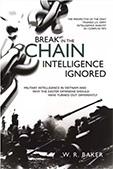As publishers and historians have now pushed the Vietnam War into a few paragraphs in a Cold War section of United States and world histories, the events contained in most discussions of the war usually ignore the Easter Offensive of 1972. If mentioned at all, it often centres on the Paris Peace Talks and Operation Linebacker but not on why and how it occurred nor the NVA[1] and VC massacres of their own people.
Despite a couple of possible forewarnings of major military action in South Vietnam sometime in the spring of 1972, the general military situation was quiet as US ground and air forces continued to be pulled out of Vietnam and South Vietnamese continued to recover from their Laos incursion in Operation Lam Son 719. That is, until early in 1972 culminating in March 1972 when agent reports increasingly filled in the puzzle to present a picture of what was to occur to the 571st Military Intelligence (MI) Detachment of the 525th MI Group. The 571st was one of four detachments (formerly, provisional battalions) in each of the four corps areas that conducted Human Intelligence (HUMINT) operations.
The intelligence was obviously ignored by ALL the major commands until after (and very reluctantly) the Easter Offensive of 1972 actually began at first light on 30 March 1972. In fact, the MACV (Military Assistance Command, Vietnam) commander, his J-2, the Ambassador to South Vietnam, and others, had left the country for the Easter holidays. The US Secretary of Defense was also headed out of town for golf in Puerto Rico. All had ignored the obvious signs and the 571st MI Detachment’s reports of the NVA entering the last, conventional, stage of protracted warfare.
The Easter Offensive of 1972 was the biggest offensive of the war to date (including Tet 1968) and one that caught the United States and South Vietnam napping. While the signs of it were present for some time beforehand, it yet again demonstrated failures that often seem to be repeated in warfare: dismissing intelligence that does not buttress the current political and/or military climate; failing to remember that the NVA and VC constantly lied in what they said and did; attributing qualities to an enemy that they didn’t have; and ignoring the new capabilities which they had recently acquired. These were among the lessons of warfare that the US Army once again had problems remembering.
The build-up in western Quang Tri Province went almost unnoticed (including Anti-Aircraft Artillery (AAA) and Surface-to-Air Missiles (SAMs). The 7th United States Air Force (USAF), which conducted the air war inside Vietnam, knew that a whole air defence division had been allowed to set up inside South Vietnam. Knowledge of this fact was also known to Washington on 30 March 30 1972, but 7th Air Force didn’t stop USAF aircraft from flying near the DMZ.
Six NVA oil pipelines (that snaked down from North Vietnam) greatly assisted NVA tanks and other vehicles to continue the invasion.
An obviously well-established Viet Cong underground railroad assisted South Vietnamese 3rd Army of the Republic of Vietnam (ARVN) Division deserters in returning to the Saigon area where most had been previously jailed.
Despite being warned by US Marine Corps Major W.E. Boomer, the ARVN commander of the 3rd ARVN Division, Brigadier General Vu Van Giai, failed to act decisively and investigate (and thereby prevent) the prepositioning of ammunition and equipment being slipped in from Laos, and of soldiers in their staging areas near their lines of departure across from the firebases (including Fire Base Sarge, where Major Boomer was, and at Nui Ba Ho, where USMC Captain Ray Smith was very close by). This allowed the 304th NVA Infantry Division and the 203rd Armored Regiment to place and sight-in their artillery and position their troops to best advantage to conduct their part of the planned blitzkrieg striking the so-called Western Defense Line by conducting operations (usually as regiments) against all the firebases in the area. This included Camp Carroll where US Army Lieutenant Colonel William Camper and US Army Major Joseph Brown tried to prevent, unsuccessfully, the surrender—without a fight—of the entire 56th ARVN Regiment and four 175mm artillery pieces.
The 308th NVA Infantry Division and 202nd Armored Regiment quickly crossed the DMZ and rolled over the first string of firebases. Continuing southward, they were forced to turn westward by the heroic efforts of USMC Captain John Ripley and US Army Major James Smock in destroying the Dong Ha Bridge. The valiant efforts of the USS Buchanan, which stayed on the gunline off the DMZ, were instrumental in these efforts.
Strategic and Tactical intelligence is more necessary today than ever. Though we didn’t know that our unit (the 571st Military Intelligence Detachment) was the only US intelligence unit still in operation in I Corps, we never let up in what our mission was.
As the offensive unfolded, we spent long hours every day putting the information together and disseminating it to anyone who could possibly be affected, influenced, or interested. We made use of the First Regional Assistance Command’s (FRAC, which used to be XXIV Corps) distribution centre to inform all the various units in I Corps, including SEALS, Army Special Forces, the Naval Intelligence Liaison Officer, 196th Light Infantry Brigade, and, of course, the FRAC headquarters components. Our information was sent twice daily by TTY (teletype) to our parent (the 525th MI Group), MACV (and their combined all-source intelligence centre, referred to as the ‘Tank’), US Army Republic of Vietnam, 7th Air Force, Pacific Fleet Intelligence, DIA, and others.
There was no intelligence failure in forecasting the Easter Offensive of 1972, commonly believed. Just as in the Battle of the Bulge and Operation Market-Garden, senior officers (as well as some intelligence officers) overlooked or disregarded Human Intelligence (HUMINT). During the Bulge, Patton’s Third Army passed its intelligence (including HUMINT information) to upper, lower, and adjacent commands—including General Eisenhower’s G-2 (military intelligence chief). During Market-Garden, Dutch HUMINT was deemed improbable, though they reported German Panzers along the British route of advance. During the Easter Offensive of 1972, HUMINT information suffered the same fate as the Bulge and Market-Garden.
The Easter Offensive of 1972 was full of many surprises that could never have been forecast (such as the surrender of an entire ARVN regiment), the success of an underground railroad for deserters, and the ‘coincidental’ swapping of firebases between two ARVN regiments (with their comms turned off) when the 130mm just happened to shower them while they were in the open. It was also a time when American and most South Vietnamese servicemen fought heroically and died tragically.
Biography

Bob Baker graduated with the first Intelligence Analyst class from Fort Huachuca, Arizona, in 1971. He was then assigned as the sole analyst to the 571st MI Detachment/525th MI Group headquartered in Da Nang, South Vietnam. The 571st was the only intelligence unit still operating in the area during the Easter Offensive of 1972.
Authoring several articles on military topics, including the Easter Offensive of 1972, for the MI Professional Bulletin/Marine Corps INTSUM, American Intelligence Journal and Vietnam magazine/10 Great Battles of Vietnam, Bob wrote Break in the Chain Intelligence Ignored, published 2021. (His book can be found worldwide, including in Russia, Hong Kong, Taiwan, and Vietnam.)
Bob has a Bachelor of Science degree from the University of Maryland and a Master of Science degree from the University of Dayton.
1 Author’s Note: The terms Viet Cong (VC) and North Vietnamese Army (NVA) are used throughout this article, rather than the more proper National Liberation Front (NLF) and People’s Army of Vietnam (PAVN). This choice was made because of the general readership’s greater familiarity with the former terms than the latter, and they are terms that have always been used by me and others while in South Vietnam. Some authors have also tried to push the fiction that the term VC is derogatory, which is preposterous.
Please let us know if you have discovered an issue with the content on this page.
Comments
Start the conversation by sharing your thoughts! Please login to comment. If you don't yet have an account registration is quick and easy.

